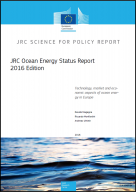Details
- Publication date
- 1 January 2017
- Author
- Joint Research Centre
Description
This report is the 2016 edition of the Joint Research Centre's ocean energy status re-port. While the 2014 edition gave an over-view of the ocean sector in the European Union, including technology descriptions, this second version focuses more on the developments that have taken place in the sector over the past years in terms of tech-no logical progress, market creation, and policy instruments available at European and national level. The various ocean energy technologies (tidal energy, wave energy, ocean thermal energy conversion and salinity gradient energy) are at different stages of technical and commercial development. In Europe, tidal and wave energy are those poised to provide the most significant con-attribution to the European energy system in the short term.
From a policy standpoint, the European Commission has strengthened its support for the development of ocean energy. Ocean energy has been identified as a key technological area within the Strategic Energy Technology Plan of the European Un-ion. As such, cost targets for wave and tidal energy have been agreed to ensure the long term uptake and viability of both tech-neologies.
The Ocean Energy Forum, supported by the European Commission, and the European Technology and Innovation Platform for Ocean Energy have delivered strategic roadmaps identifying key hurdles of the sector, and specific recommendations for each ocean energy technology.
The key bottlenecks that the ocean energy sector faces moving forwards are very similar to those hindering it in 2014: tech-neology development, financing of projects; and concerns regarding unknown environ-mental impacts slowing down consenting and licensing of projects.
The extent to which each barrier prevents market formation is specific to each technology. Ocean thermal energy conversion and salinity gradient technology are still at early stage of development, requiring re-search and development to progress further in terms of technology.
Wave energy has yet to prove consistent electricity generation to the level reached by prototype tidal energy converters. Technology progression for wave energy is par-amount to ensure the long-term growth of the sector. Reliability, availability and survivability are the three areas that wave energy developers need to address.
The deployment of the first demonstration arrays for tidal energy indicates that technology progression has been achieved. The main challenge for the tidal sector moving forward is to achieve cost-reduction of the technology through the deployment of more demonstration projects. Innovative financial instruments are required for sup-porting the deployment of the first projects and attracting private investors.
The installation of ocean energy devices is taking place at a slower pace than expected. Europe only accounts for 14 MW of ocean energy installed capacity at the end of 2016, much lower than the expectation set by Member States in their National Renewable Energy Action Plans. According to NREAPs, 641 MW of ocean energy capacity were expected to be operational by 2016, taking into account the 240 MW tidal range currently operational in France.
By 2020, if technological and financial barriers are overcome, the pipeline of announced European projects could reach 600 MW of tidal stream and 65 MW of wave energy capacity. Taking into account only projects that have been awarded public funds, 71 MW of tidal stream and 37 MW of wave energy capacity could be operational within the EU in 2020.
The next few years will be fundamental to understand how far and how fast the markets for both wave and tidal energy technology can be formed.
Seizing the opportunity offered by the development of ocean energy will not affect only the decarbonisation of the European energy system, but will play a direct role in assuring the competitiveness of European industry. The European Union is at the fore-front of technology development, with about 50 % of tidal energy and about 60 % of wave energy developers being located in the European Union. The majority of ocean energy infrastructure, such as ocean energy test centres, is also hosted in the European Union. European technology is being employed in key demonstration projects that have become operational at the end of 2016 in the United Kingdom and Canada.
The supply chain is spread across Europe, and the creation of ocean energy market is expected to affect positively many Europe-an regions.
A wide number of support mechanisms implemented at European, national and regional levels are currently supporting the development of ocean energy, from re-search and development through demonstration. Whilst, additional and innovative instruments need to be created to over-come specific barriers and support demonstration projects, the commitment of the European Commission and its Member State is strong to ensure that ocean energy can become a commercial reality.

